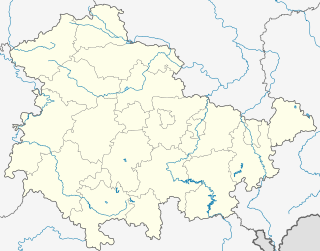Barbarossa Cave
| Barbarossa Cave
|
||
|---|---|---|
|
Plaster cloth (2005) |
||
| Location: | Kyffhauser , Germany | |
|
Geographic location: |
51 ° 22 '31 " N , 11 ° 2' 12" E | |
|
|
||
| Geology: | Anhydrite (Werra sequence) | |
| Type: | hypogenic layer boundary cave (Schlotte Wimmelburger type) | |
| Discovery: | 1865 | |
| Show cave since: | 1866 | |
| Lighting: | electric (since 1895) | |
| Overall length: | 1100 meters | |
| Length of the show cave area: |
800 meters | |
| Average annual number of visitors: | 65,000 | |
| Current visitors: | 70,000 (2016) | |
| Particularities: | • Plaster rag • Alabaster eyes • Snake plaster |
|
| Website: | www.hoehle.de | |
The Barbarossa Cave is one of two accessible anhydrite caves in the world. It is a chimney in anhydrite ( gypsum ) in Kyffhäuser near Rottleben ( Thuringia ). The cave includes wide cavities, grottos and lakes. The anhydrite changes to plaster of paris due to the humidity in the cave and increases in volume. The resulting layers of plaster gradually detach themselves from the subsurface and hang, like falling wallpaper, on the ceilings and walls of the underground cavities. They are called a plaster flap . The air temperature is 10 ° C, the water temperature 8.5 ° C. There is a hydraulic connection to the Arens Fountain.
The Barbarossa Cave is located on the Karst hiking trail .
history
The Barbarossa Cave was discovered on December 20, 1865 while driving a tunnel for copper slate mining and was expanded and opened in 1866 as a show cave with the name Falkenburger Höhle . It was renamed Barbarossahöhle as early as 1866 when the Fürstlich Schwarzburg-Rudolstädtische Bergmeister zu Könitz Friedrich Herthum (1828-1882) used this name on the mine plan he had drawn. The name Barbarossahöhle found its way into literature from 1868 when Herthum published the first publication on the cave. It has a floor area of around 15,000 m². Interesting for visitors are the underground lakes, shimmering green due to the gypsum content, as well as the so-called table and chair by Barbarossa .
Kyffhauser legend
Its location in the Kyffhäuser Mountains establishes its connection to the Barbarossa legend . According to legend, Emperor Friedrich I Barbarossa is to sleep in an underground castle until Germany is united. His beard grows around a round table. So far he has reached around twice, but when he has finished the third round, the end of the world begins or Barbarossa wakes up and begins his rule again. And it is said that no good emperor will come by then.
Trivia
The board game Barbarossa and the Riddlers takes up the legend of the cave as a game theme.
See also
literature
- Günter Behm-Blancke: Cave sanctuaries cannibals. An archaeological factual report from the Kyffhäuser. Dingsda-Verlag, Querfurt / Leipzig 2005, ISBN 3-928498-86-X .
- Michael K. Brust: The Barbarossa Cave in Kyffhäuser. ARTE fact publishing house, Kyffhäuserland 2015, ISBN 978-3-937364-30-8
Web links
- https://www.barbarossahoehle.de
- The "Barbarossa Cave " near Rottleben in the Kyffhäuser Mountains, description of the geotope of the Thuringian State Institute for Environment and Geology (TLUG)
- Show caves in Germany: Barbarossahöhle. In: showcaves.com. Retrieved May 17, 2016 .
- Barbarossa Cave. In: kyffnet.de. Retrieved May 17, 2016 .
Individual evidence
- ↑ Barbarossa's underground realm. In: nnz-online.de. Retrieved May 17, 2016 .
- ^ A b Michael K. Brust: The Barbarossa Cave in Kyffhäuser. ARTE fact publishing house, Kyffhäuserland 2015, ISBN 978-3-937364-30-8
- ↑ fountain: Pfanne / Pfannenspring nature reserve. In: karstwanderweg.de. Retrieved November 28, 2018 .
- ^ Friedrich Herthum: The Barbarossa Cave near Frankenhausen on the southern edge of the Kyffhäuser Mountains illuminated in their interesting geological phenomena . Wartig, Leipzig 1868 (16 pages).




